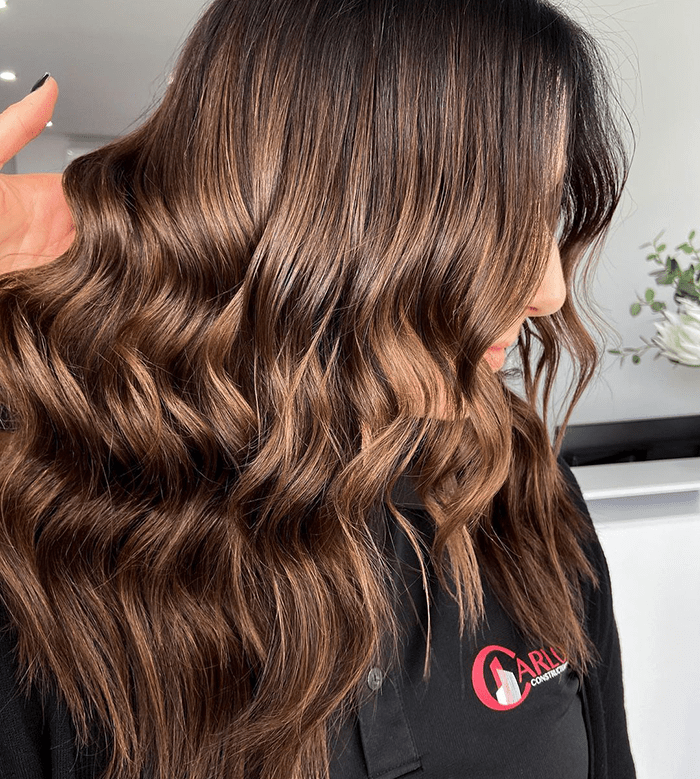
Should You Exfoliate Your Scalp? Yes And Here’s Why.
Seeing Gen Z skip over the painful drugstore phase of their adolescent years is evidence that beauty routines can always be upgraded.
We’ve taken exfoliation from gritty apricot face scrubs to simple and effective over-the-counter chemical peels.
You’re welcome for our years of isopropyl alcohol-based services, btw.
And we’re completely expediting the whole “why haven’t I been doing this for years” thing with new, unheard-of exfoliants and washing methods.
So, one has to wonder:
Should you exfoliate your scalp too?
Oh, yeah.
Enter your haircare upgrade: scalp scrubs.
These granular hair heroes are your hair’s answer to refined beauty routines:
They remove sweat, product build-up, dandruff, and any other uncomfortable scalp residues that may prevent hair growth.
And they’re kind of for everyone:
Have a dry or flakey scalp?
Using a scalp scrub will break down and remove the excess sebum and flakes.
Have excess oil?
A scrub will help clarify sweat build-up that your shampoo might miss.
We’ll get into the nitty gritty on scalp scrubs: how to use them and why a DIY scalp exfoliator is the best route.
And of course:
A recipe to master your own DIY scalp scrub for dandruff and all other clarifying needs.
Read Next: How To Relieve an Itchy Scalp
Wearing The Medium Halo in col. #2/4
How To Use a Scalp Scrub
The mechanics of a scalp scrub may seem pretty straight forward.
I mean… the instructions are right in the name.
But, there’s some fine print on the whole literal scalp scrub thing.
Let’s get into each.
Should I scalp scrub before or after shampoo?
We suggest using your DIY scalp scrub pre-shower and pre-shampoo for a couple reasons.
Many higher end, store-bought, Gwyneth approved versions are quite dry.
Not to mention…
Do we really know what ingredients like Dimethicone are?
But, because the other guys have dryer consistencies, these are often in-shower options that don’t require a long (and nourishing) soaking process.
Presenting: an abridged list of why we love a DIY.
When making you’re own secret sauce, there’s a bit of moisture to work with already:
You have the ability to get closer to a paste than a seasoning.
Plus!
DIY scalp scrubs usually have added beneficial oils in them without any other chemical, fragrance, or additive stuff, so it’s amazing to let them sit for 10-15 minutes.
Okay.
Nothing’s stopping you from doing that in the shower, but make sure not to lose any formula in the line of fire (the shower stream).
How to Use a Scalp Scrub:
On dry hair, use your scalp scrub by applying directly to your scalp and massaging for a few minutes (strength and length depend on how bad your buildup is)
Get in the shower and rinse it out
Shampoo, condition, hair mask, make a phone call as usual 😎
One reason we model our routine like this is so your shampoo can get any leftover granules or residue.
And just how often should you scalp scrub?
Once a week is great, but keep checking in with your scalp.
If you have bad buildup or oil, once a week is ideal.
But, if you have only slight buildup or you’re just in the scalp scrub game because it feels soooo good then dial back the frequency.
Read Next: How To Hydrate (By Hair Type)
Wearing The Thick Halo in col. #60
Should You Exfoliate Your Scalp?
We say overwhelmingly yes.
(Um, did you read our praise for scalp treatments above?)
But aside from their BFF material, there is a wrong way to exfoliate your scalp.
You’d think the act of cleaning scalp buildup is hard to mess up or really overdo.
But, what makes something so right SO WRONG is doing it too often or using a formula too strong.
What’s too often: If you already have a fairly healthy scalp and you use too strong of a scrub, you can actually create a problem where one didn’t exist.
What’s too strong: Too strong is usually a store-bought problem: if they include acid exfoliators like AHAs or larger, harder granules, this could be a lot on some scalps.
So, are scalp scrubs bad?
No, definitely not.
When you don’t go blindly into exfoliation.
Read Next: The Causes of Oily Hair And How To Fix It
Wearing The Medium Halo in col. #613
The Recipe: Scalp Scrub For Dandruff DIY
Yes, this recipe is for dandruff mostly, but we’re giving tweaks to make it your own when you’re not sure if it’s product build-up, sebum overproduction, or something between dry scalp and dandruff.
Ingredients:
1/4 cup of jojoba or avocado oil (for moisture)
3/4 cup baking soda (for fine exfoliation)
5-10 drops of tea tree oil (for anti-fungal properties)
2 tablespoons apple cider vinegar (for PH balancing, anti-bacterial goodness)
1 tablespoon Manuka honey (for moisture)
Directions:
Mix into a paste
Using circular motions, massage into scalp for 5 minutes
Allow to sit for at least 10 minutes
Rinse off in the shower
Read Next: Why Jamaican Black Castor Oil Is Incredible For Hair Growth
Why Is This A Winning Combo?
Salt scrubs can be pretty drying because of the sodium;
Although clarifying, it can dry your mid-sections and ends out.
As well, the larger and more course attributes of salt (like that of Himalayan salt) can be a little too abrasive on some scalps.
Baking soda has a much finer texture that allows this scalp scrub to get right in between strands while also being naturally clarifying.
Throw in some tea tree oil and ACV and you get your anti-bacterial, anti-fungal, and anti-microbial goodness to fight off any sebum overproduction too.
Not to mention, ACV is PH balancing.
Meaning: hair is shinier, frizz-free, healthy, and cuticle-sealed.
Lastly, our use of oils and honey are the difference maker (personal pats for this one).
As mentioned, anything that’s clarifying can be a bit drying.
So we fix that from the start with added, non-comedogenic oils that aren’t too heavy for fine hair.
But, Manuka is the star ingredient in moisture here.
It’s a natural humectant that attracts and retains moisture from scalp to end.
Meaning you get smooth, frizz-fighting, moisturized locks from the root.
When To Swap Out Baking Soda For Sugar
For textured hair such as those with 4C curls, the salt in most scrubs can leave you very dry.
Although baking soda is easier on the dryness than salt, getting just a liiiiittle more moisture is important for these hair types.
While you won’t get as much impurity pull-out, sugar provides a nice, fine exfoliator that’ll soften your scalp.
When To ADD Salt:
Get in there, girl.
This is for when you have a lot of build-up or very dirty hair.
Add an additional 1/3-1/2 cup of course salt (like sea salt or Himalayan) to provide your scalp with both large and fine physical exfoliators.
We suggest to not remove the baking soda entirely as you’ll still want something fine in there too.
As always, take a close look at your scalp and check in with the state of your buildup to see if you need to go hard or not.
You Might Also Like:
Scalp Sebum: What You Need to Know About Sebum on Your Scalp
DIY Deep Conditioning Treatment At Home For Dry Hair
